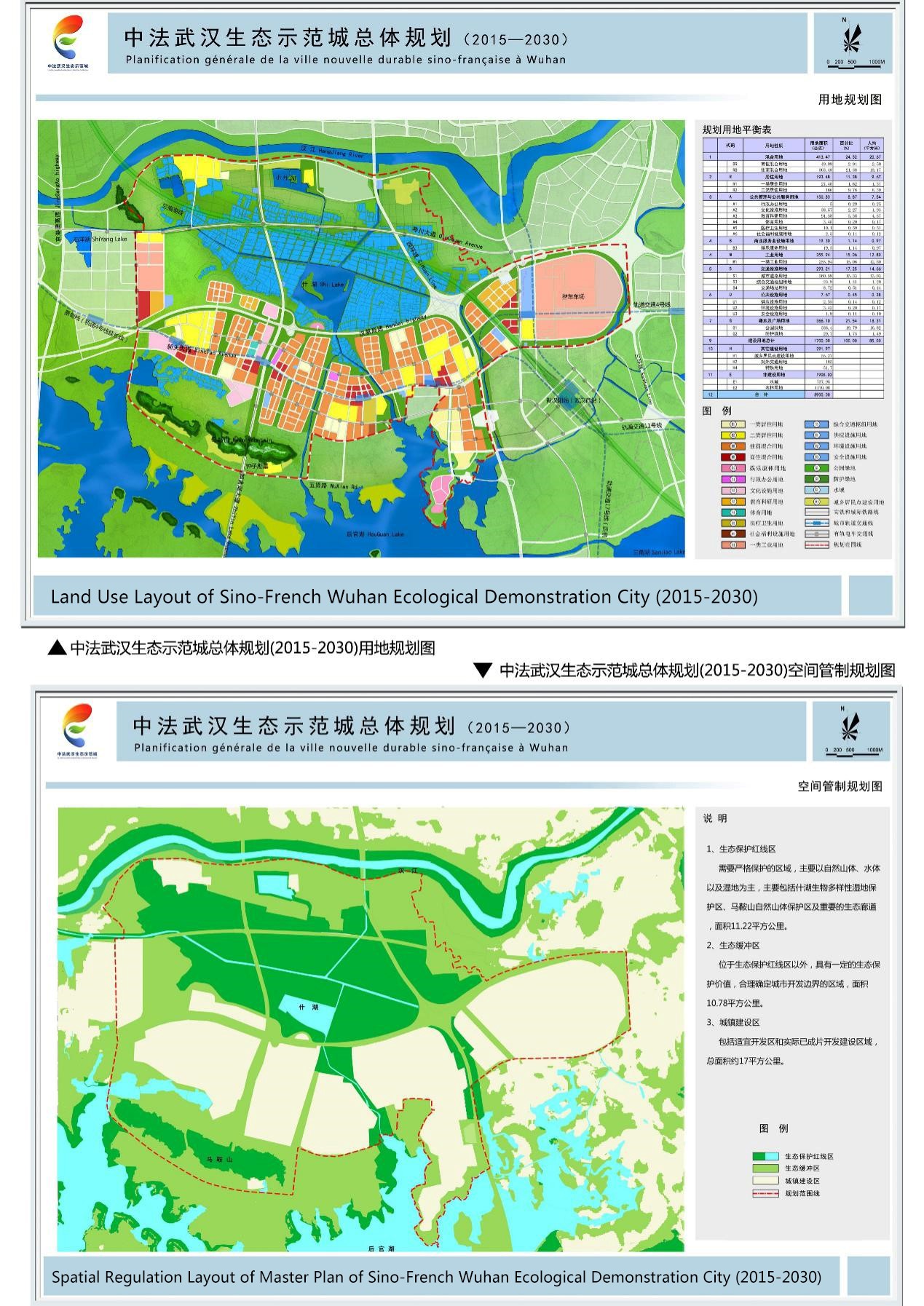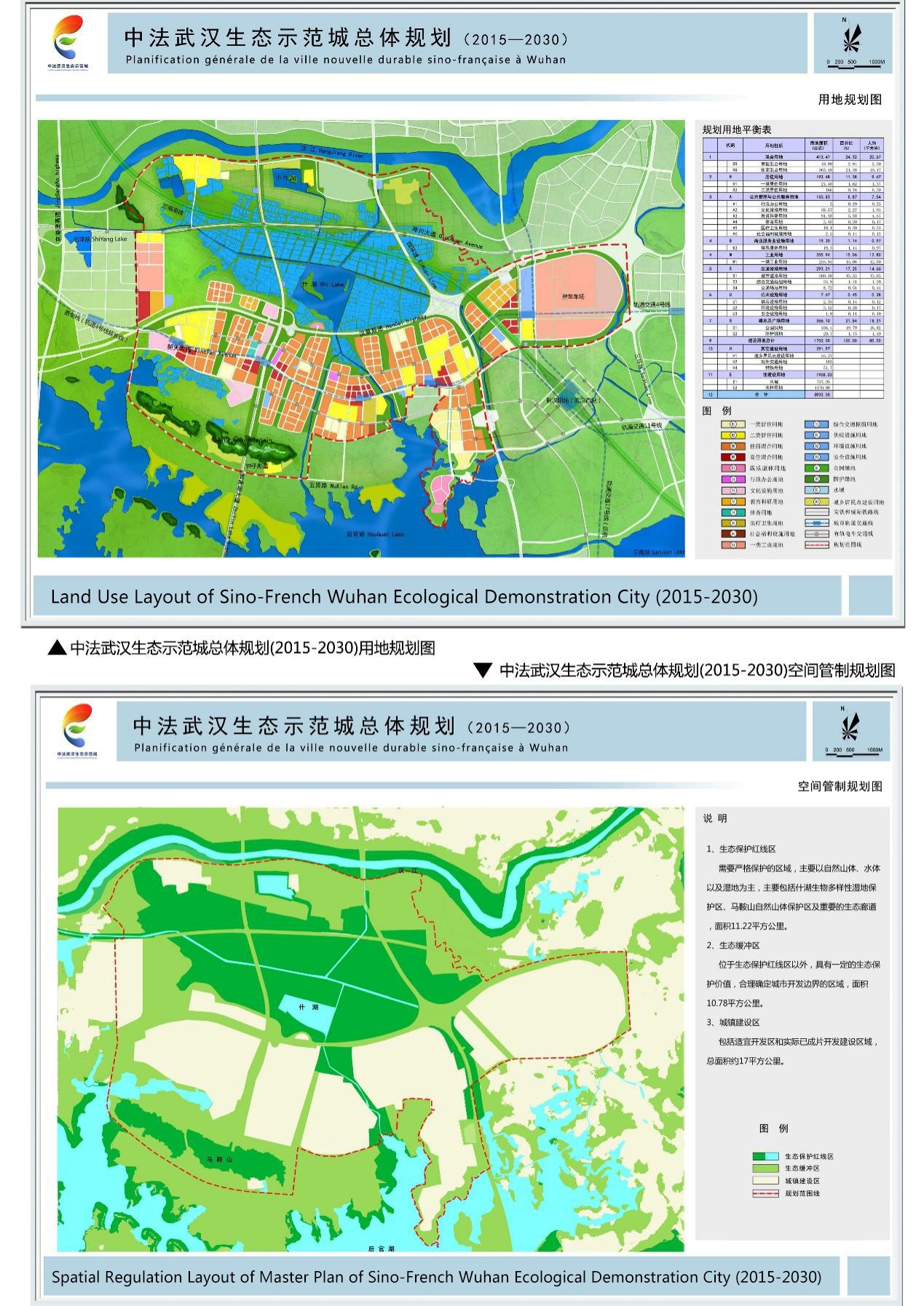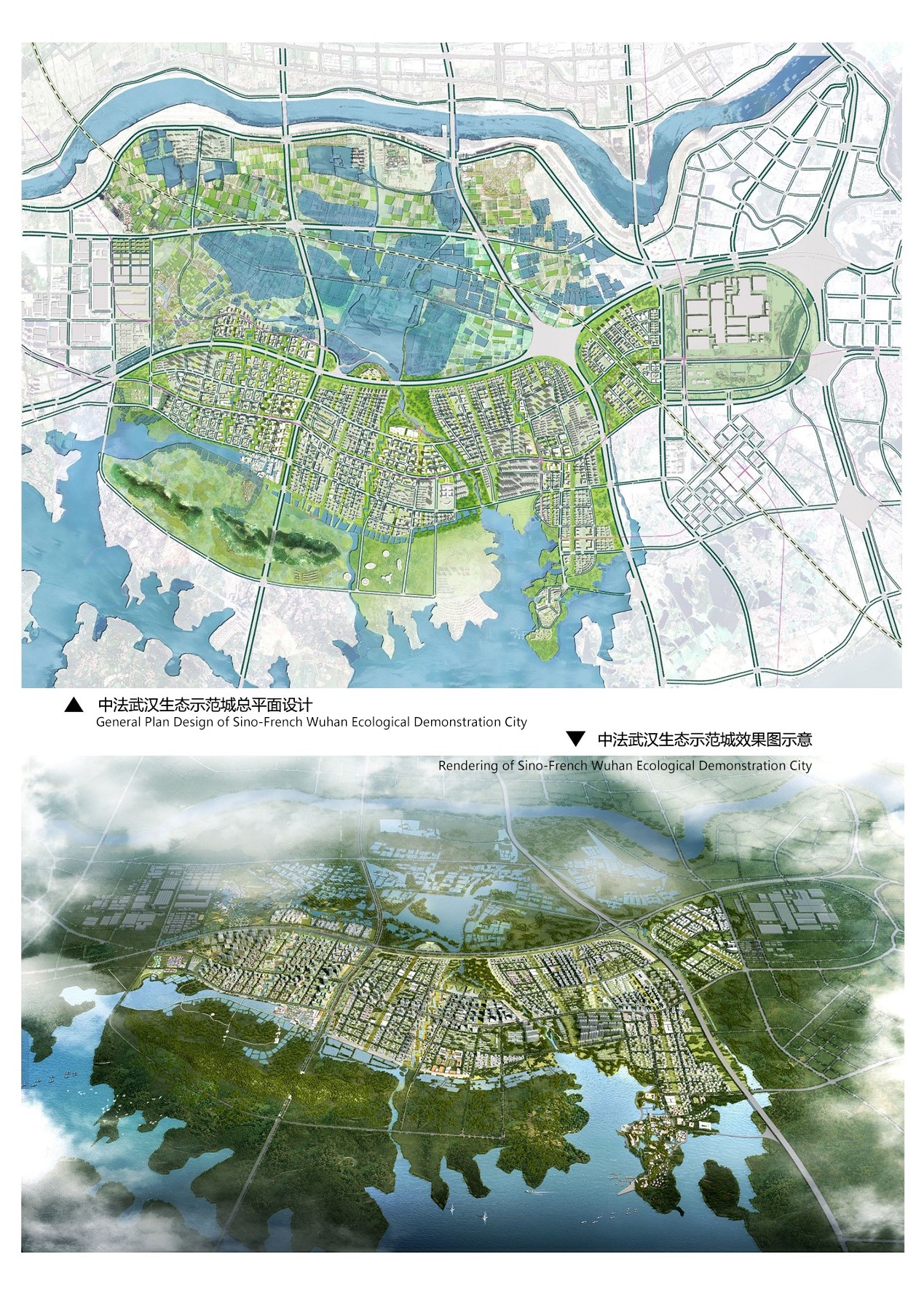Sustainable Development Practice of Sino-French Cooperation in Coping with Climate Change--Master Plan of Sino-French Wuhan Ecological Demonstration City
Description
In 2014, the heads of state of China and France signed the Letter of Intent on Constructing Sino-French Wuhan Ecological Demonstration City as a sustainable development practice of Sino-French cooperation in coping global climate change. Based on the sustainable technologies and experience of China and France in the fields of urban planning, construction and management, the project will implement the concept of low carbon, ecology and industry-city integration, value renewable energy utilization and ecological environment technologies, highlight the low carbon transport system and green building application, and promote the development of technology R&D and innovation.
Sino-French Wuhan Ecological Demonstration City is positioned as a sustainable demonstration zone through which developing countries cope with environmental problems, an eco-prioritized and livable new city in China's Yangtze River Economic Belt, as well as a world-renowned, appealing, high-added-value and knowledge-based platform for Sino-French technical cooperation and cultural exchanges.<br />
<br />
China has entered the stage of fast urbanization and achieved great success, but brought along many environmental problems: While becoming the world's second-largest economy, China is becoming the world's largest carbon emitting country. As climatic and environmental problems are becoming increasingly urgent, global consensus on energy conservation and emission reduction is becoming clearer. At the 2015 United Nations Climate Change Conference in Paris, in its "Intended Nationally Determined Contributions", China stated that it would peak carbon emissions and raise the proportion of non-fossil energy in primary energy to 20 percent by 2030. The master plan of Sino-French Wuhan Ecological Demonstration City was unveiled at the conference for the first time, and was promoted as a practice and exploration of sincere cooperation between a developed country and a developing country in addressing global climatic and environmental problems.<br />
<br />
The concept of Sino-French Wuhan Ecological Demonstration City highly tallies with the concept of "innovation, coordination, green, opening and sharing" proposed by the Chinese government, and fits in with the eco-civilization construction advanced by China. The Chinese government also stressed that China must take a long-term view, take a road of ecology priority and green development, and develop on the basis of environmental protection in order to promote the development of the Yangtze River Economic Belt. The project should strengthen the concept of respect for nature, historical inheritance and low carbon, take environmental capacity and urban carrying capacity as the basis of determining city orientation and scale, initiatively advance green, cyclic and low carbon development, first create an industrial structure, growth pattern and consumption mode of energy resource conservation and environmental protection, and extend them to the rest of the country.<br />
<br />
The project will promote the development of technology R&D and innovation, build Sino-French Tech Valley, and make the zone an important economic growth pole in Wuhan's urban development area.<br />
<br />
China and France will cope with challenges in fields such as global climate change and environmental protection, explore more sustainable models of urban development, and push forward all-round cooperation and exchanges in fields such as urban planning, building, transportation, housing and energy efficiency. As both countries have long history and profound cultural deposits, the project will become an important platform for Sino-French cultural exchanges.
(1) Eco-regional Zoning
The Ecological Demonstration City has identified and has been comprehensively monitoring ecological conservation red line, ecological buffer zone and ecological town with the support of technologies like ENVI and ArcGIS and field survey.
(2) Industrial Distribution Innovation
The first industry in the Ecological Demonstration City highlights its demonstrative role in ecology to introduce urban vertical farming technology and construct an eco-agricultural demonstration garden; its second industry emphasizes the demonstrative role in hi-tech to realize industrial transformation on the basis of the current auto manufacturing, the R&D of new energy vehicles and energy conservation and environmental protection industry; its third industry focuses on specialization by developing supporting functions including the R&D, aftermarket and sharing services for relevant industries (automotive and logistics industries) followed by the constructions of innovative and cultural industries like Sino-France tech valley, training center for art and cultural exchange, international health industry, urban agriculture demonstration center, and etc.
(3) Intensive Use of Land
The Ecological Demonstration City made itself an integrated part of the current urban construction by incorporating Sino-France tech valley and reserving among the current large-scale industrial and residential land and residential areas surrounding Ma An Mountain a certain amount of land for R&D use, and adopting TOD model to innovatively develop mixed utilization of high, medium and low lands.
(4) Prioritizing Green Transportation
The construction of overall transportation network highlights the priority of public transportation, importance of ecological conservation and integration of infrastructure and road landscape, and adopts the model of “dense network and small blocks” to build a public transportation network of multiple layers which emphasizes the concept of green transportation.
(5) Public Space Sharing
Based on an ecological sponge system made up of “northern and southern rainfall garden, multi-level eco-canals and micro recycling penetrative channels” and incorporated with city landscape and public functions, the city has realized the sharing and integration of ecological and public spaces as well as the sustainable management and efficient utilization of natural resources. By adopting four-level sharing block system consisting of new town, village, community and neighborhood centers and building a 15-minute community life circle, it has equalized public services and improved the rate of agricultural landscapes and green roofs of high streets to facilitate the penetration of agricultural landscape into communities.
(6) Eco Technology Application
The city has developed an integrated cycling management system of water, energy and wastes to ensure the application of ecological technologies and the coordination of water management, waste collection and management, energy utilization and urban agriculture.
(7) Indicator System Monitoring
The city has built an indicator system for future monitoring highlighting innovation, coordination, green energy, opening-up and sharing with 24 items of indicators based on actual development progress.
The city attracted its investment through holding international forums. The 4th Sino-French Urban Sustainable Development Forum in 2017 saw 21 projects signed on site with a total investment of RMB126.2 billion and letters of intent signed with French enterprises including Electricity of France and Bureau Veritas.
Currently, the Ecological Demonstration City is developing at a fast pace, with 1.4 kilometers of the largest key infrastructure project in its early stage, the 13-kilometer underground pipe gallery completed in its first phase under the Public-Private Partnership (PPP) Model. The pipe gallery, integrating electricity, gas, thermal energy, communications, water supply and drainage pipes, is currently Wuhan’s comprehensive pipe gallery project of highest monitoring and intelligence level which adopts high-tech to enable intensive land use and save energy. Built as the permanent venue for Sino-French Urban Sustainable Development Forum and Sino-France Ecological Demonstration City exhibition hall, the futuristic city designed with international vision featuring non-impact construction, zero pollution, original landscape and postmodernism has generally finished establishment. The city has involved French hi-tech enterprises in the ecological governance of Shihu Lake to develop ecological water recycle system and city green land ecosystem which can serve as a model for international application; 110-kilometer round-Houguan Lake-green land has been completed; Sino-French Friendship Bridge, Rail Transit Line 4 and other infrastructure have begun to taken shape; six industries including culture experience consumption, high-end international health care, conservative ecology, smart green transportation, new generation of information technology and entrepreneur & startup company services are still in their early stage. With energy supply system enabled by safe, effective and sustainable new technologies and green, low-carbon and recycling industrial system underway, the city’s utilization rate of renewable energy can reach up to 20%.
With the region’s mountains, lakes, wetlands, part of farmlands and villages left intact, the greening rate of the city is projected to be 45% and public green land per capita, 16.8 square meters.
(1) High concentration of French enterprises and talent. Since Citroen made its presence in Wuhan in 1992, over a hundred of French enterprises followed suit, making the region a crucial cluster for French enterprises and talent with solid foundation for Sino-France cooperation.
(2) Convenient transportation network. Located only 8 kilometers to Wuhan’s downtown area, the project is supported by new Hanyang High Speed Railway Station, 3 highways, 2 rail transit lines, 3 city ring roads and several expressways. The region is positioned to be the major transportation hub in western Wuhan equipped with a transportation network of high-speed railways, intercity railways, rail transit lines, tramcars and highways to enable quick commute between 3 towns in Wuhan and its city circle.
(3) Beautiful ecological environment. Home to several mountains, lakes and rivers, the region boasts of a total forest coverage of 40,000 Mus (over 90%) by the nearby Jouzhen Mountain and Songyang Mountain national forest parks with Houguan Lake national wetland park covering more than 70 square kilometers, making it the largest green lung in the suburbs of Wuhan.
(4) Rich cultural background. The region is the origin of a famous Chinese story about friendship between Zhong Ziqi and Yu Boya.
(5) Strong industrial base. The region has already developed a relatively completed industrial system supported by Wuhan Development Zone, Wuhan Airport Economic Development Zone, Caidian Changfu Industrial Development Zone and Zhuankou and Fenghuang Mountain Industrial Park, offering a solid foundation for Indus development.
(6) Positive cooperation environment. With low population density, balanced land use and a total buildable land of 108.58 square kilometers, the region has great potential for further exploitation.
2. Constraints
Currently, as China has overtaken the US as the world’s largest carbon emitter, Wuhan is faced with environmental threats like high carbon consumption, high carbon emission, climate change, environment pollution and high demand for personal cars. Therefore, the Ecological Demonstration City should take on the responsibility to develop low carbon development plan, build low carbon industrial system and advocate low carbon green lifestyle and consumption model.
Chinese government has launched an overall plan on economic, political, cultural, social and ecological construction to place ecological development in the same position as economic and social development, marking China has transformed from a superficial development model featuring the overconsumption of resources driven by factors of production and investment to a more profound, technology-oriented model driven by innovation and wealth highlighting the integration of economy, society and environment. The city should also be committed to exploring a new type of urbanization development model for developing countries.
(2) The city facilitates the upgrading and transformation of the Ecological Demonstration City’s industrial economy to form an industrial system pillared by high-end service industries, based on auto manufacturing and R&D, and complemented by demonstrative ecological industries, taking economic productivity to the next level, highlights the integration of industrial and city development as well as the balance between the number of residents and local job openings, promotes energy conservation and improves efficiency to mitigate the negative impact of city development on the climate.
(3) The city encourages land planning models featuring multiple uses of land to build dynamic communities and achieve low-carbon lifestyle; provides multiple types of spaces for technological innovation, encouraging the construction of built-in innovation space, increasing the number of decent work, advocates entrepreneurship, creativity and innovation, and emphasizes and promotes the development of micro-, small- and medium-sized enterprises.
(4) The city has built a comprehensive transportation network featuring high efficiency, green energy and low-carbon emission and advocates public transportation and slow-speed travel to ensure the rate of green transportation above 90% in a bid to play a demonstrative role in promoting low-carbon development and energy conservation, improving efficiency and addressing climate change.
(5) In order to ensure enough spaces for ecological development, the city has calculated the carrying capability of the environment on the basis of water security framework, the net primary productivity of natural vegetation, ecological footprint model and Carbon-oxygen balance method; it encourages the planting of special crops and the construction of pastoral complex and has built vertical farm and roof planting to establish a comprehensive urban agricultural demonstration zone which can increase efficient carbon sink and provide material base for countering climate change.
(6) The city utilizes natural environment to build an efficient public space system under sustainable management and integrated with ecological sponge system, city landscape and public functions; it has built a 15-minute community life cycle to promote the equalization of public services facilitate the penetration between different public services, enhanced the coverage of compulsive education and created a work environment with sufficient job opportunities; improved the coverage of agricultural landscape and green roofs in high street, increased efficient carbon sink in urban area to mitigate the impact of climate change.
(7) The city has developed an ecological cyclic management system with a coordinated incorporation of cyclic water purification, energy usage, collection and multiple usages of wastes, intelligent ecological recycling, urban agriculture, green construction and smart city to ensure the application of ecological technologies.
Through the strategic cooperation between China and France, the Ecological Demonstration City has gathered the top theories and technologies in fields ranging from city and architecture design, environmental protection, energy utilization to climate change, built cycling economic system and offered demonstrative construction proposal regarding water system, collection and handling of wastes, energy utilization, green transportation, urban agriculture and smart city.<br />
<br />
For water cycling system, the city adopts a model incorporating water monitoring, wastewater management and natural rehabilitation to enhance the use of rain and wastewater, recycles wastewater to provide power for buildings’ heating and cooling demands and builds ecological sponge system to improve its counter-flood ability, contributing to a 40% decrease in water consumption and over 30% utilization rate of recycled water, and keeping water use per GDP under 8 tons/ RMB10,000.<br />
<br />
For the collection and multiple utilization of wastes, the recycling rate of the city’s bio-wastes has reached over 70% through the upgrading of the waste collection and management model.<br />
<br />
For energy utilization, the city resorts to bioclimatological method to reduce heat island effect, develops “zero-energy” constructions to facilitate the intensive use of energy, fully utilizes solar and thermal energy and industrial waste heat, recycles thermal energy from Shihu Lake and underground water and adopts world leading technologies for air purification. The energy it generated can meet 70% of the energy need with the utilization rate of recycled energy over 20%.<br />
<br />
For comprehensive transportation, the city has gradually completed a comprehensive transportation system highlighting convenient connection and public transportation, achieving 100% coverage of bus stations every 300 meters and ensuring the rate of green transportation over 90%.<br />
<br />
For urban agriculture, the suburban area is equipped with roof greenhouses, hydroponic greenhouses and vertical farms in countering climate restraints. The city also implements environmental protection measure (erosion prevention, soil fertility maintenance, conservation of water and energy resources) to reduce the negative impact on resources and environment.<br />
<br />
For smart city development, the city has developed a comprehensive smart city management system incorporating smart transportation, resources, information and environment through the establishment of smart control and management center.<br />
<br />
At the end of 2015, as a solution to address global climate issues with the cooperation between a developed country and a developing country, the overall plan and design outcomes of Sino-France Ecological Demonstration City made its debut at climate change conference in Paris, demonstrating the city’s development concept of low carbon and the integration of industrial and city development and its determination to serve as model for international ecological construction.
http://www.zfsttz.com/
(II) Published Papers
1. Measures and Time of Ecological City Planning from a Perspective of Eco-civilization, Song Jie/Cheng Wangjie, Issue 1 (2018), Planners
2. Case Analysis of Ecological City Practice amid Sino-Foreign Cooperation, Yang Zhengguang/Xu Hao, Sixth 21st Century Urban Development Conference
3. Practice of Urban Green Development in Wuhan, Song Jie/Cao Yujie/Kang Jingjing/Tong Dandan, ISOCARP Review 2018
4. Integration of Ecological City-Exploration and Practice of Sino-French Wuhan Ecological Demonstration City, Song Jie/He Hao, China Architecture & Building Press ISBN 978-7-112-22681-8
(III) News Reports
1. March 2014, witnessed by the heads of state of China and France, the representatives of the Chinese and French governments signed the Letter of Intent on Constructing Sino-French Wuhan Ecological Demonstration City, people.com.cn;
2. January 2015, China and France initiates Ecological City planning to build world-class new demonstration city, ifeng.com;
3. March 2015, Sino-French Wuhan Ecological Demonstration City planning initiated, cities in different countries seek common ground, ifeng.com;
4. November 2015, "Co-building of Sino-French Wuhan Ecological New City"-1st Sino-French Forum on City Sustainability took place in Sino-French Wuhan Ecological Demonstration City, Chinese and French experts unveiled the master plan of the city, gmw.cn.
5. In November 2015, Plan of Sino-French Wuhan Ecological New City to be unveiled at UN Climate Conference, Changjiang Daily
6. January 2016, Sino-French Wuhan Ecological Demonstration City included as national strategy, Hubei Daily
7. September 2016, 3rd Sino-French Forum on City Sustainability opens in Wuhan, people.com.cn
8. February 2017, French Prime Minister Gérard Cazeneuve visited Sino-French Wuhan Ecological Demonstration City and attended Sino-French Wuhan Ecological Demonstration City Global Presentation, the master plan was unveiled, chinanews.com
9. September 2017, 4th Sino-French Forum on City Sustainability takes place in Wuhan: Chinese and foreign enterprises signed 21 projects with Sino-French Wuhan Ecological Demonstration City, with a total investment of 126.2 billion yuan, Hubei Daily.
10. In October 2018, Sino-French Wuhan Ecological Demonstration City unveils Outline of Action for Decade Development, chinanews.com
SDGS & Targets
Deliverables & Timeline
Resources mobilized
Partnership Progress
| Name | Description |
|---|
Feedback
Action Network


Timeline
Entity
Region
- Asia and Pacific
Geographical coverage
Photos



Website/More information
Countries

Contact Information
Dandan Tong, Nil
